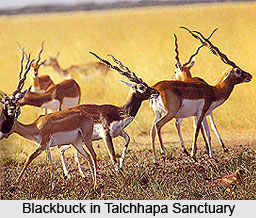 Talchhapar Sanctuary is a wildlife sanctuary situated in Churu District in the north-western part of Rajasthan, in the Shekhawati area of the country, celebrated for its concentration of blackbucks and numerous other birds. It is based at a distance of nearly 210 kms away from Jaipur city along the borders of the Thar Desert, particularly on the road which leads to Sujangarh from Ratangarh. It is present on the Nokha-Sujangarh State Highway about 85 km away from Churu and 132 km away from Bikaner. Talchhapar Sanctuary was believed to be a favourite hunting spot for the Maharaja of Bikaner. It was pronounced as a protected region of wild beasts and birds during 1962, and occupies an area measuring 719 hectares.
Talchhapar Sanctuary is a wildlife sanctuary situated in Churu District in the north-western part of Rajasthan, in the Shekhawati area of the country, celebrated for its concentration of blackbucks and numerous other birds. It is based at a distance of nearly 210 kms away from Jaipur city along the borders of the Thar Desert, particularly on the road which leads to Sujangarh from Ratangarh. It is present on the Nokha-Sujangarh State Highway about 85 km away from Churu and 132 km away from Bikaner. Talchhapar Sanctuary was believed to be a favourite hunting spot for the Maharaja of Bikaner. It was pronounced as a protected region of wild beasts and birds during 1962, and occupies an area measuring 719 hectares.
Geography of Talchhapar Sanctuary
Talchhapar Sanctuary has been named so in the honour of Chhapar village which is present at 27° 50 minutes north and 74° 25 minutes east. The sanctuary is existent in a flat, saline depression region referred to as `Tal` ecosystem. It exists at an altitude of 302 metres above mean sea level. Prosopis trees and acacia are observed in various parts of the sanctuary, which make it resemble the Savanna grasslands. The term `Tal` implies plane landscapes. Winters continue from October till February, monsoons remain from July to September and summers remain from March to June. During summer, extreme hot winds known as `loo` blow throughout the sanctuary.
Flora and Fauna of Talchhapar Sanctuary
Talchhapar Sanctuary is categorized as one of the tropical forests of the nation and contains a vast quantity of grasses and a few trees. Migratory birds like harriers are seen here, and even other birds which involve Demoiselle Cranes, Tawny Eagles, Little Green Bee-Eaters, Black Ibis, Short-Toed Eagle, Crested Lark, Sparrow, Blue Jay, Skylark, Ring Dove, Partridge, Sand Grouse, Desert Cat and Desert Fox. A unique species of grass termed as `Mothiya`, which has been derived from `Moti`, an English word for pearl. Mothiya grass is sweet in taste and its seeds are shaped like round pearls. Blackbucks and many other birds feed on Mothiya grass. Lana, Dhaman Lampla, Sewan and Doob are some of the various grasses found here.



















